Research in this Unit is focused on working on the design and development of new molecular assemblies and functional materials, often beyond the traditional molecular dimension scale.
As such the research encompasses biological assemblies (DNA and peptide based), supramolecular architectures and nanoscale materials. These new assemblies and materials are designed to address issues relating to the major challenges faced by society today, including energy, healthcare and diagnostics. Our research is supported by the Centre for Chemical and Materials Analysis, which offers high quality spectroscopic analysis, including, but not limited to, NMR, Mass Spectrometry, X-ray Diffraction and HPLC.
Research Collaborations
BSNC team leaders are actively engaged with both industrial and academic partners within the UK and internationally as well as in collaborative projects across the University (Schools of Biosciences, Chemical Engineering and Physics and Astronomy, and the College of Medical and Dental Sciences). This includes cross-disciplinary areas of research activity covered by all three of the School of Chemistry’s research themes, Materials Chemistry and Energy, Chemical Biology and Drug Discovery and Chemistry for Healthcare Technologies.
Areas of Expertise
Molecular and biomolecular recognition; supramolecular architectures; nanoparticles; self assembly and self organisation; liquid crystals; bioinorganic systems; light and redox sensitive sensors; photophysics and photochemistry; peptide design; DNA recognition motifs; luminescent labels; metallo-drugs and imaging agents; molecular imaging.
Research Group Leaders and examples of their work
Dr Francisco Fernandez-Trillo
In Situ Functionalized Polymers for siRNA Delivery.
Juan M. Priegue, Daniel N. Crisan, José Martinez-Costas, Juan R. Granja, Francisco Fernandez-Trillo and Javier Montenegro.
Angew. Chem. Int. Ed., 2016, 55, 7492-7495.
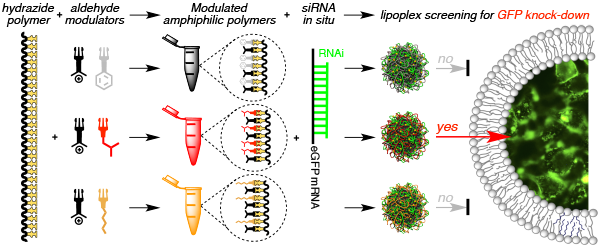
We describe a new method to synthesise and in situ screen polymeric amphiphiles (PAs) and evaluate them in the delivery of small interfering RNA (siRNA). A poly(acryloyl hydrazide) scaffold is modified using readily available aldehydes to explore of a broad range of functionalities suitable for membrane permeability. The activity of PAs can be in situ evaluated using both model membranes and model cell lines, without PA isolation and purification, with is the most common limitation of current strategies. This method constitutes an improved alternative to current screening methods and can underpin the discovery of new functional polymers with complex chemical functionality.
Accessible Synthetic Probes for Staining Actin inside Platelets and Megakaryocytes by Employing Lifeact Peptide
Lucia Cardo, Steve G. Thomas, Alexandra Mazharian, Zoe Pikramenou, Joshua Z. Rappoport, Michael J. Hannon and Stephen P. Watson
ChemBioChem 2015, 16, 1680-1688.
De Novo Design of Ln(III) Coiled Coils for Imaging Applications
Matthew R. Berwick, David J. Lewis, Zoe Pikramenou, Andrew W. Jones, Helen J. Cooper, John Wilkie, Melanie M. Britton and Anna F. A. Peacock.
J. Am. Chem. Soc., 2014, 136, 1166-1169.
Featured in an article in The Conversation.
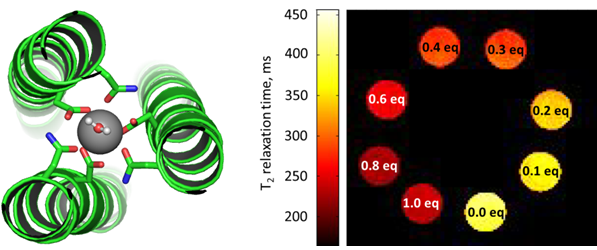
A new peptide sequence (MB1) has been designed which, in the presence of a trivalent lanthanide ion, has been programmed to self-assemble to form a three stranded metallo-coiled coil, Ln(III)(MB1)3. The binding site has been incorporated into the hydrophobic core using natural amino acids, restricting water access to the lanthanide. The resulting terbium coiled coil displays luminescent properties consistent with a lack of first coordination sphere water molecules. Despite this the gadolinium coiled coil, the first to be reported, displays promising magnetic resonance contrast capabilities.
Luminescent Gold Surfaces for Sensing and Imaging: Patterning of Transition Metal Probes
Samuel J. Adams, David J. Lewis, Jon A. Preece and Zoe Pikramenou
ACS Appl. Mater. Interfaces 2014, 6, 11598-11608.
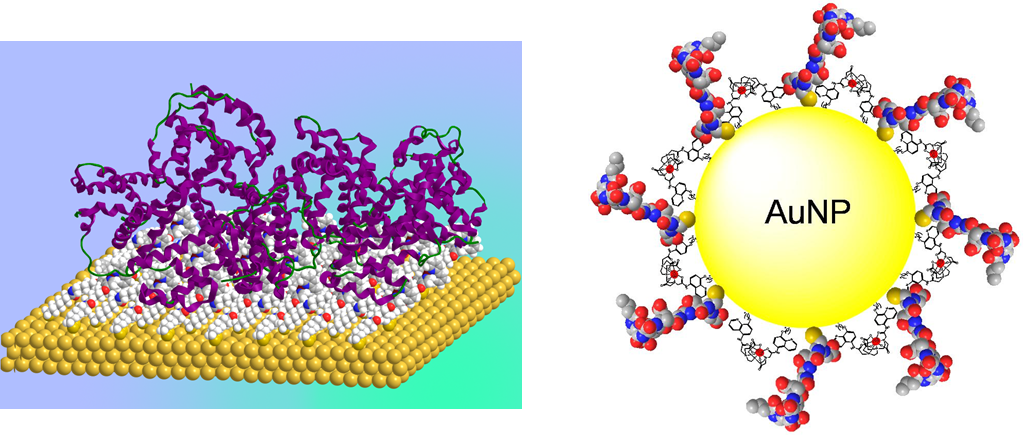
Luminescent metal complexes on surfaces and nanoparticles in detection of proteins and bioimaging.
Modulation of Biointeractions by Electrically Switchable Oligopeptide Surfaces: Structural Requirements and Mechanism
Chun L. Yeung, Xingyong Wang, Minhaj Lashkor, Eleonora Cantini, Frankie J. Rawson, Parvez Iqbal, Jon A. Preece, Jing Ma and Paula M. Mendes
Adv. Mater. Interfaces 2014, 1, 1300085
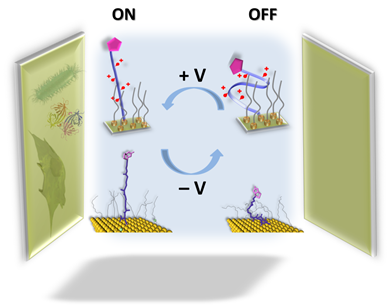
This paper explores electrically switchable SAMs formed from oligopeptides, via the use of both experimental and computational approaches to provide details on the conformational changes that occur upon switching and the structural requirement at a molecular level and also in terms of the SAM composition. Understanding this dynamic behaviour of switchable surfaces is of paramount importance for the development of controllable tailor made surfaces, for use in diagnostics and sensing.
Macrocyclic Metal Complex−DNA Conjugates for Electrochemical Sensing of Single Nucleobase Changes in DNA
Jean-Louis H. A. Duprey, James Carr-Smith, Sarah L. Horswell, Jarosław Kowalski and James H. R. Tucker
J. Am. Chem. Soc. 2016, 138, 746−749.
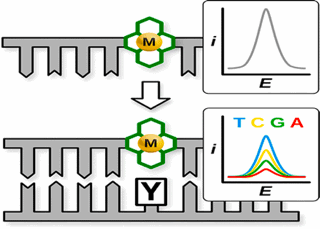
The direct incorporation of macrocyclic cyclidene complexes into DNA via automated synthesis results in a new family of metal-functionalized DNA derivatives that readily demonstrate their utility through the ability of one redox-active copper(II)-containing strand to distinguish electrochemically between all four canonical DNA nucleobases at a single site within a target sequence of DNA.
Research associated with this unit also includes that undertaken by or in partnership with colleagues in other Schools, including Hanene Ali-Boucetta and Youcef Mehellou.
Contact us
Enquiries about specific aspects of their research areas should be addressed to individual research group leaders. For more general enquiries about working with the BSN Unit, please contact Dr Francisco Fernandez-Trillo (BSN Unit Lead). Information is also available on various postgraduate (PhD and Masters) degree opportunities and postdoctoral and fellowship opportunities.